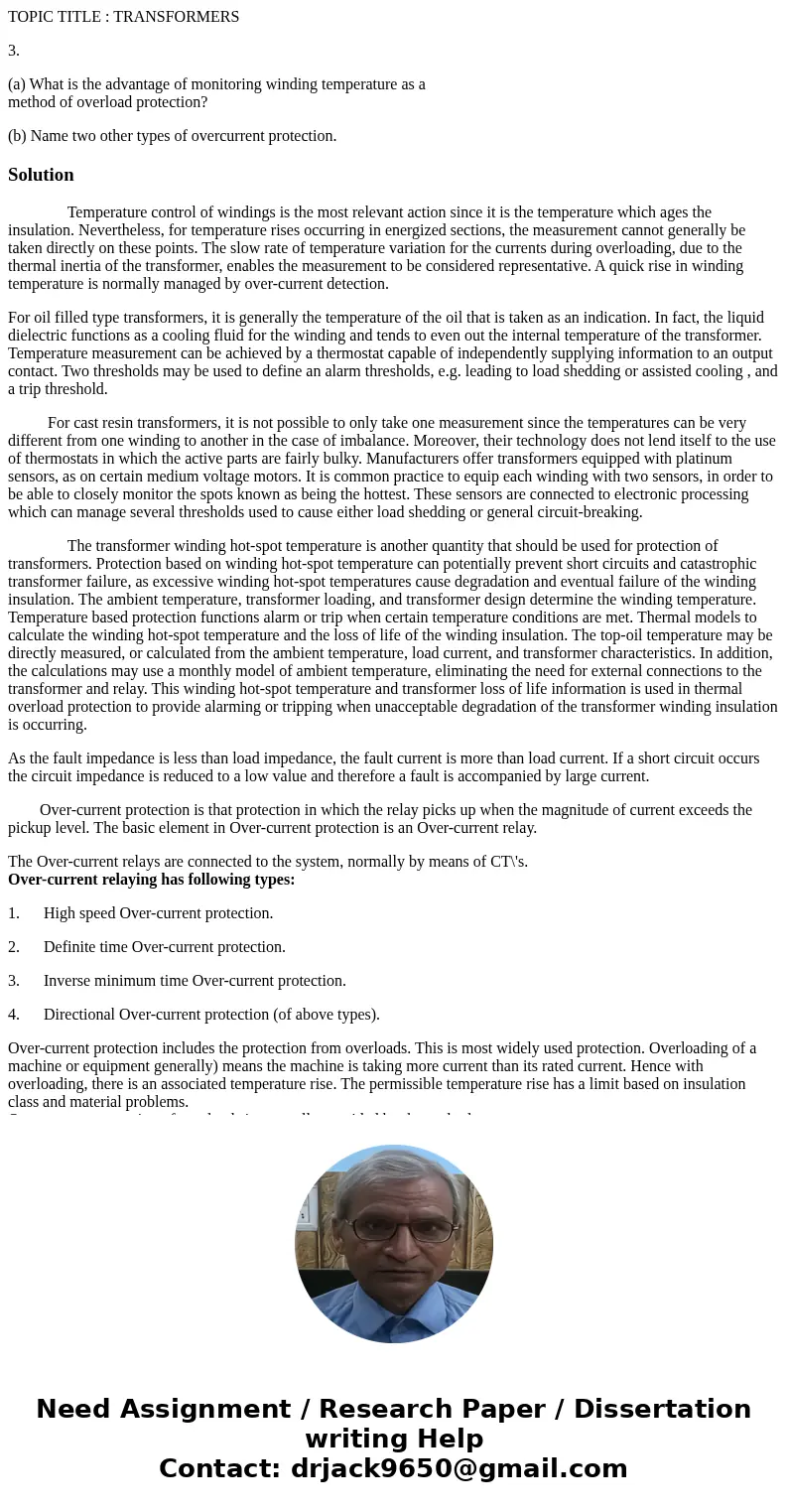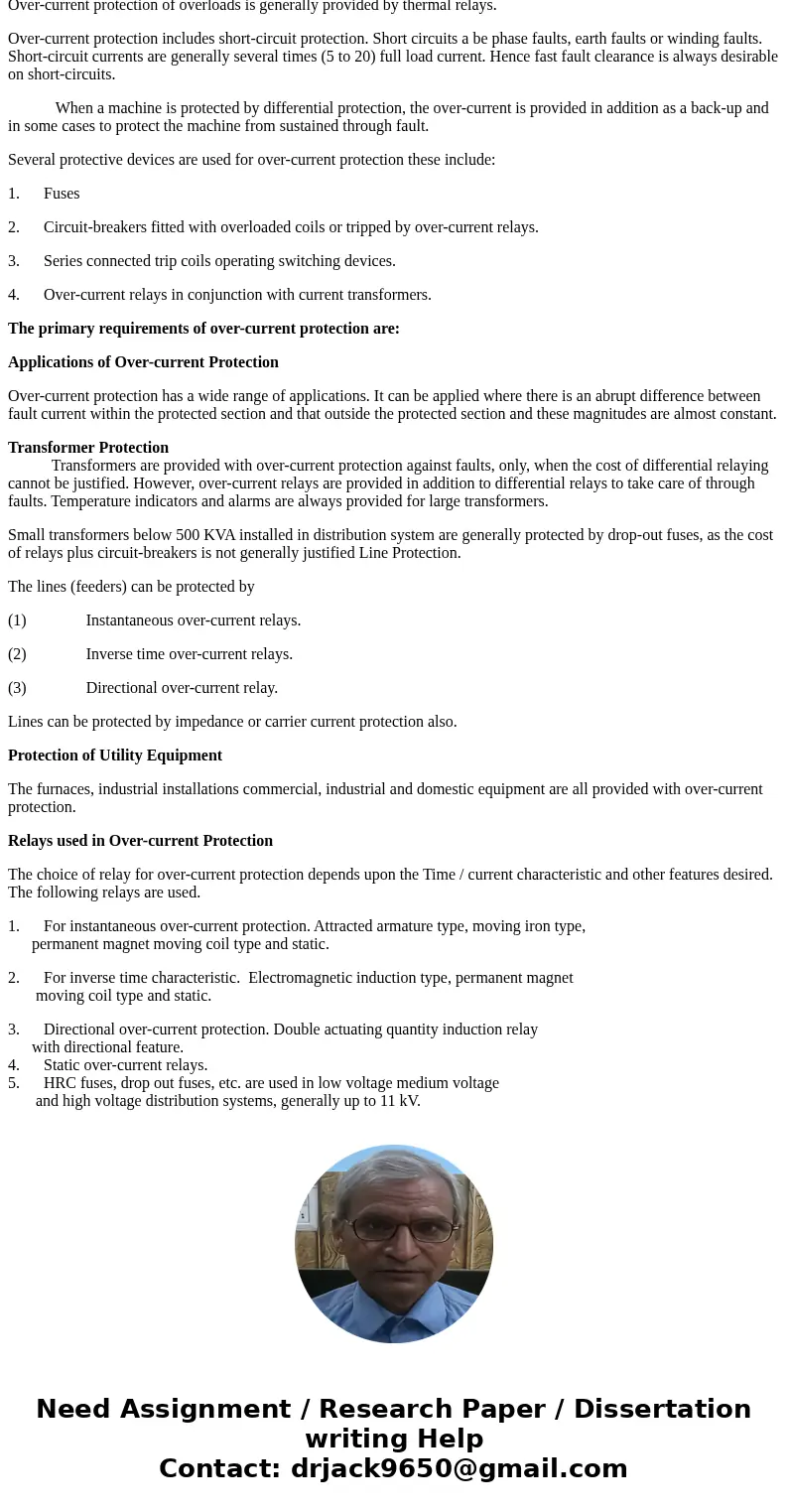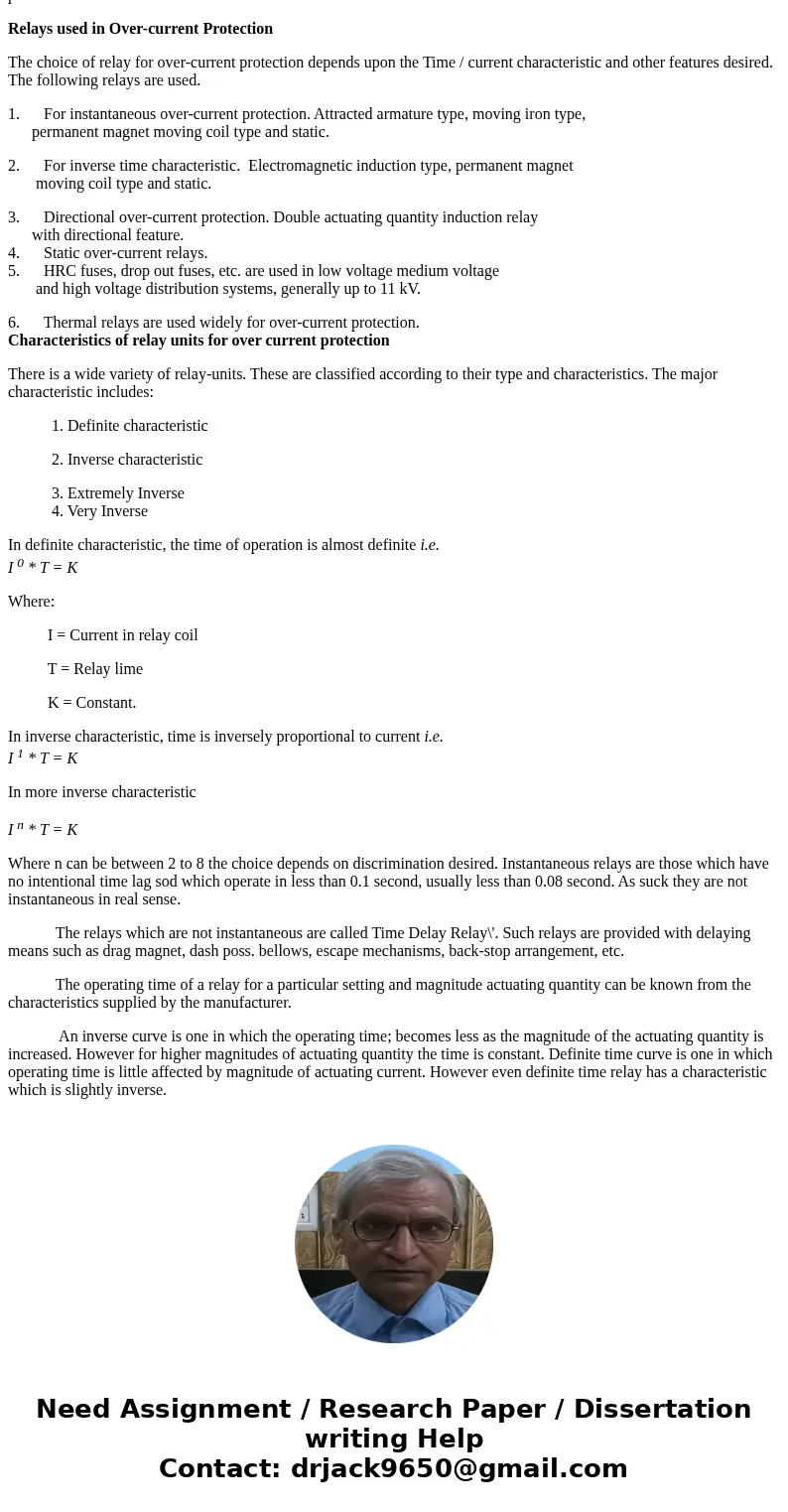TOPIC TITLE TRANSFORMERS 3 a What is the advantage of monit
TOPIC TITLE : TRANSFORMERS
3.
(a) What is the advantage of monitoring winding temperature as a
method of overload protection?
(b) Name two other types of overcurrent protection.
Solution
Temperature control of windings is the most relevant action since it is the temperature which ages the insulation. Nevertheless, for temperature rises occurring in energized sections, the measurement cannot generally be taken directly on these points. The slow rate of temperature variation for the currents during overloading, due to the thermal inertia of the transformer, enables the measurement to be considered representative. A quick rise in winding temperature is normally managed by over-current detection.
For oil filled type transformers, it is generally the temperature of the oil that is taken as an indication. In fact, the liquid dielectric functions as a cooling fluid for the winding and tends to even out the internal temperature of the transformer. Temperature measurement can be achieved by a thermostat capable of independently supplying information to an output contact. Two thresholds may be used to define an alarm thresholds, e.g. leading to load shedding or assisted cooling , and a trip threshold.
For cast resin transformers, it is not possible to only take one measurement since the temperatures can be very different from one winding to another in the case of imbalance. Moreover, their technology does not lend itself to the use of thermostats in which the active parts are fairly bulky. Manufacturers offer transformers equipped with platinum sensors, as on certain medium voltage motors. It is common practice to equip each winding with two sensors, in order to be able to closely monitor the spots known as being the hottest. These sensors are connected to electronic processing which can manage several thresholds used to cause either load shedding or general circuit-breaking.
The transformer winding hot-spot temperature is another quantity that should be used for protection of transformers. Protection based on winding hot-spot temperature can potentially prevent short circuits and catastrophic transformer failure, as excessive winding hot-spot temperatures cause degradation and eventual failure of the winding insulation. The ambient temperature, transformer loading, and transformer design determine the winding temperature. Temperature based protection functions alarm or trip when certain temperature conditions are met. Thermal models to calculate the winding hot-spot temperature and the loss of life of the winding insulation. The top-oil temperature may be directly measured, or calculated from the ambient temperature, load current, and transformer characteristics. In addition, the calculations may use a monthly model of ambient temperature, eliminating the need for external connections to the transformer and relay. This winding hot-spot temperature and transformer loss of life information is used in thermal overload protection to provide alarming or tripping when unacceptable degradation of the transformer winding insulation is occurring.
As the fault impedance is less than load impedance, the fault current is more than load current. If a short circuit occurs the circuit impedance is reduced to a low value and therefore a fault is accompanied by large current.
Over-current protection is that protection in which the relay picks up when the magnitude of current exceeds the pickup level. The basic element in Over-current protection is an Over-current relay.
The Over-current relays are connected to the system, normally by means of CT\'s.
Over-current relaying has following types:
1. High speed Over-current protection.
2. Definite time Over-current protection.
3. Inverse minimum time Over-current protection.
4. Directional Over-current protection (of above types).
Over-current protection includes the protection from overloads. This is most widely used protection. Overloading of a machine or equipment generally) means the machine is taking more current than its rated current. Hence with overloading, there is an associated temperature rise. The permissible temperature rise has a limit based on insulation class and material problems.
Over-current protection of overloads is generally provided by thermal relays.
Over-current protection includes short-circuit protection. Short circuits a be phase faults, earth faults or winding faults. Short-circuit currents are generally several times (5 to 20) full load current. Hence fast fault clearance is always desirable on short-circuits.
When a machine is protected by differential protection, the over-current is provided in addition as a back-up and in some cases to protect the machine from sustained through fault.
Several protective devices are used for over-current protection these include:
1. Fuses
2. Circuit-breakers fitted with overloaded coils or tripped by over-current relays.
3. Series connected trip coils operating switching devices.
4. Over-current relays in conjunction with current transformers.
The primary requirements of over-current protection are:
Applications of Over-current Protection
Over-current protection has a wide range of applications. It can be applied where there is an abrupt difference between fault current within the protected section and that outside the protected section and these magnitudes are almost constant.
Transformer Protection
Transformers are provided with over-current protection against faults, only, when the cost of differential relaying cannot be justified. However, over-current relays are provided in addition to differential relays to take care of through faults. Temperature indicators and alarms are always provided for large transformers.
Small transformers below 500 KVA installed in distribution system are generally protected by drop-out fuses, as the cost of relays plus circuit-breakers is not generally justified Line Protection.
The lines (feeders) can be protected by
(1) Instantaneous over-current relays.
(2) Inverse time over-current relays.
(3) Directional over-current relay.
Lines can be protected by impedance or carrier current protection also.
Protection of Utility Equipment
The furnaces, industrial installations commercial, industrial and domestic equipment are all provided with over-current protection.
Relays used in Over-current Protection
The choice of relay for over-current protection depends upon the Time / current characteristic and other features desired. The following relays are used.
1. For instantaneous over-current protection. Attracted armature type, moving iron type,
permanent magnet moving coil type and static.
2. For inverse time characteristic. Electromagnetic induction type, permanent magnet
moving coil type and static.
3. Directional over-current protection. Double actuating quantity induction relay
with directional feature.
4. Static over-current relays.
5. HRC fuses, drop out fuses, etc. are used in low voltage medium voltage
and high voltage distribution systems, generally up to 11 kV.
6. Thermal relays are used widely for over-current protection.
Characteristics of relay units for over current protection
There is a wide variety of relay-units. These are classified according to their type and characteristics. The major characteristic includes:
1. Definite characteristic
2. Inverse characteristic
3. Extremely Inverse
4. Very Inverse
In definite characteristic, the time of operation is almost definite i.e.
I 0 * T = K
Where:
I = Current in relay coil
T = Relay lime
K = Constant.
In inverse characteristic, time is inversely proportional to current i.e.
I 1 * T = K
In more inverse characteristic
I n * T = K
Where n can be between 2 to 8 the choice depends on discrimination desired. Instantaneous relays are those which have no intentional time lag sod which operate in less than 0.1 second, usually less than 0.08 second. As suck they are not instantaneous in real sense.
The relays which are not instantaneous are called Time Delay Relay\'. Such relays are provided with delaying means such as drag magnet, dash poss. bellows, escape mechanisms, back-stop arrangement, etc.
The operating time of a relay for a particular setting and magnitude actuating quantity can be known from the characteristics supplied by the manufacturer.
An inverse curve is one in which the operating time; becomes less as the magnitude of the actuating quantity is increased. However for higher magnitudes of actuating quantity the time is constant. Definite time curve is one in which operating time is little affected by magnitude of actuating current. However even definite time relay has a characteristic which is slightly inverse.



 Homework Sourse
Homework Sourse